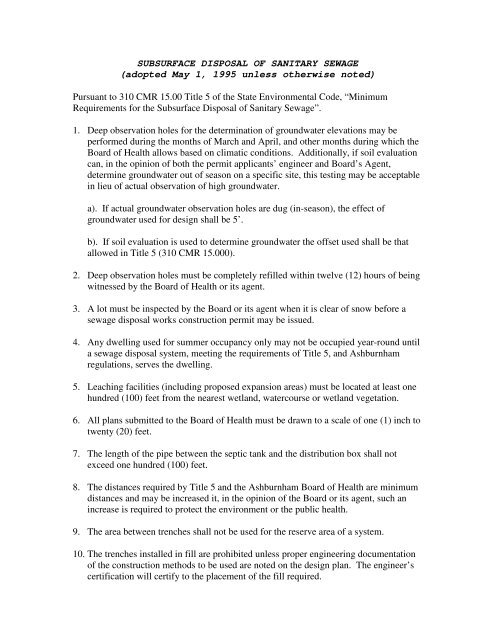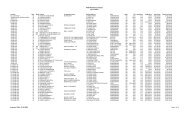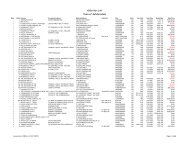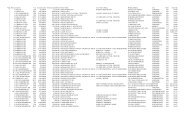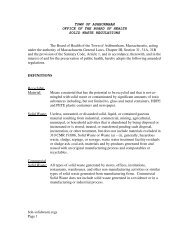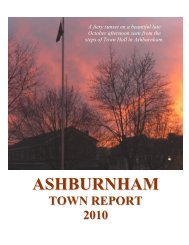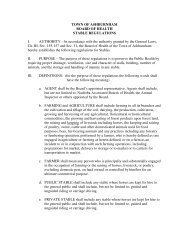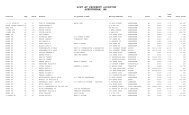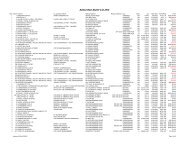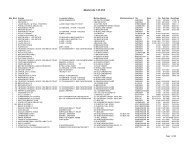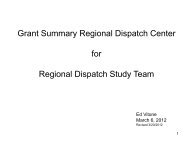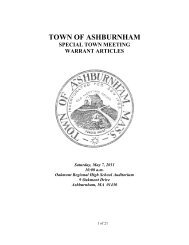Sanitary Sewage Disposal Regulations - Town of Ashburnham ...
Sanitary Sewage Disposal Regulations - Town of Ashburnham ...
Sanitary Sewage Disposal Regulations - Town of Ashburnham ...
Create successful ePaper yourself
Turn your PDF publications into a flip-book with our unique Google optimized e-Paper software.
SUBSURFACE DISPOSAL OF SANITARY SEWAGE<br />
(adopted May 1, 1995 unless otherwise noted)<br />
Pursuant to 310 CMR 15.00 Title 5 <strong>of</strong> the State Environmental Code, “Minimum<br />
Requirements for the Subsurface <strong>Disposal</strong> <strong>of</strong> <strong>Sanitary</strong> <strong>Sewage</strong>”.<br />
1. Deep observation holes for the determination <strong>of</strong> groundwater elevations may be<br />
performed during the months <strong>of</strong> March and April, and other months during which the<br />
Board <strong>of</strong> Health allows based on climatic conditions. Additionally, if soil evaluation<br />
can, in the opinion <strong>of</strong> both the permit applicants’ engineer and Board’s Agent,<br />
determine groundwater out <strong>of</strong> season on a specific site, this testing may be acceptable<br />
in lieu <strong>of</strong> actual observation <strong>of</strong> high groundwater.<br />
a). If actual groundwater observation holes are dug (in-season), the effect <strong>of</strong><br />
groundwater used for design shall be 5’.<br />
b). If soil evaluation is used to determine groundwater the <strong>of</strong>fset used shall be that<br />
allowed in Title 5 (310 CMR 15.000).<br />
2. Deep observation holes must be completely refilled within twelve (12) hours <strong>of</strong> being<br />
witnessed by the Board <strong>of</strong> Health or its agent.<br />
3. A lot must be inspected by the Board or its agent when it is clear <strong>of</strong> snow before a<br />
sewage disposal works construction permit may be issued.<br />
4. Any dwelling used for summer occupancy only may not be occupied year-round until<br />
a sewage disposal system, meeting the requirements <strong>of</strong> Title 5, and <strong>Ashburnham</strong><br />
regulations, serves the dwelling.<br />
5. Leaching facilities (including proposed expansion areas) must be located at least one<br />
hundred (100) feet from the nearest wetland, watercourse or wetland vegetation.<br />
6. All plans submitted to the Board <strong>of</strong> Health must be drawn to a scale <strong>of</strong> one (1) inch to<br />
twenty (20) feet.<br />
7. The length <strong>of</strong> the pipe between the septic tank and the distribution box shall not<br />
exceed one hundred (100) feet.<br />
8. The distances required by Title 5 and the <strong>Ashburnham</strong> Board <strong>of</strong> Health are minimum<br />
distances and may be increased it, in the opinion <strong>of</strong> the Board or its agent, such an<br />
increase is required to protect the environment or the public health.<br />
9. The area between trenches shall not be used for the reserve area <strong>of</strong> a system.<br />
10. The trenches installed in fill are prohibited unless proper engineering documentation<br />
<strong>of</strong> the construction methods to be used are noted on the design plan. The engineer’s<br />
certification will certify to the placement <strong>of</strong> the fill required.
11. A minimum <strong>of</strong> four (4) feet must be available between the primary and expansion<br />
leaching facilities.<br />
12. The sewage disposal system must be located on the same lot as the facility it is<br />
intended to serve; for the purpose <strong>of</strong> this regulation, a lot shall not be interconnected<br />
by an easement or right-<strong>of</strong>-way.<br />
13. No privy, humus or self-contained toilet may be used without the written permission<br />
<strong>of</strong> the Board <strong>of</strong> Health. Such permission shall indicate the period <strong>of</strong> time for which<br />
such a facility may be used and in no case shall exceed one (1) year. Permanently<br />
installed privies, humus or self-contained toilets must receive written permission<br />
annually.<br />
14. Every request for a variance shall be made in writing and shall state the specific<br />
variance sought and the reasons therefore. No variance shall be granted for a new<br />
sewage disposal system, repair, nor for an enlargement to an existing system which<br />
increases capacity to accommodate additional flows, except after the applicant has<br />
notified all abutters by certified mail at his own expense at least 10 days before the<br />
Board <strong>of</strong> Health meeting at which the variance request will be on the agenda. The<br />
notification shall state the specific variance sought and the reason therefore. (adopted<br />
Oct. 2, 1989)<br />
15. The area <strong>of</strong> land defined by a circle with a twenty-five (25) foot radius around a<br />
failing percolation test shall be deemed unsuitable for sewage disposal.<br />
16. The area <strong>of</strong> land defined by a circle with a twenty-five (25) foot radius around a deep<br />
observation hole with less than the prescribed amount <strong>of</strong> pervious, naturally occurring<br />
soil, as described in Title 5 (310 CMR 15.000), shall be deemed unsuitable for<br />
sewage disposal.<br />
17. Mounding<br />
When an individual proposes a sewage disposal system in excess <strong>of</strong> 2,000 gallons per<br />
day, groundwater-mounding analysis will be acquired as part <strong>of</strong> the design<br />
information submitted to obtain a <strong>Sewage</strong> Works Construction Permit.<br />
18. Innovative System<br />
When an individual proposes to use one <strong>of</strong> the Department <strong>of</strong> Environmental<br />
Protection’s approved innovative systems for the design <strong>of</strong> a sewage disposal system,<br />
they must also receive approval from the Board <strong>of</strong> Health.<br />
19. If an applicant for a sewage disposal work permit construction claims the right to use<br />
the 1978 Code (Title 5, 310 CMR 15.00). The <strong>Ashburnham</strong> Board <strong>of</strong> Health<br />
regulations in effect on March 1, 1995 and before shall govern the design <strong>of</strong> the<br />
system.
20. The following uses are prohibited in the Watershed Protection District as defined by<br />
<strong>Ashburnham</strong> Zoning By-Laws <strong>of</strong> the <strong>Town</strong> <strong>of</strong> <strong>Ashburnham</strong>. Where the location <strong>of</strong> a<br />
boundary is uncertain the burden <strong>of</strong> pro<strong>of</strong> shall be upon the owner(s) <strong>of</strong> the land in<br />
question and subject to <strong>Town</strong> Zoning By Laws 2.25, 2-g.<br />
a). The replacement or repair <strong>of</strong> an existing subsurface sewage disposal system<br />
which results in an increase in design capacity greater than the design capacity <strong>of</strong> the<br />
existing system(s).<br />
b). Individual sewage disposal systems that are designed to receive more than 110<br />
gallons <strong>of</strong> sewage per quarter per day or 440 gallons <strong>of</strong> sewage per acre per day,<br />
whichever is greater, provided that; the replacement or repair <strong>of</strong> the existing system<br />
which will not result in design capacity above the original design, shall be exempted.<br />
21. In the Floodway, designated on the Flood Boundary and Floodway map, with any<br />
boundary disputes being determined according to the <strong>Town</strong>s Zoning By Laws 2.25,<br />
a-g, the following provision shall apply.<br />
a). New construction requiring the installation <strong>of</strong> a subsurface sewage disposal<br />
system is prohibited.


